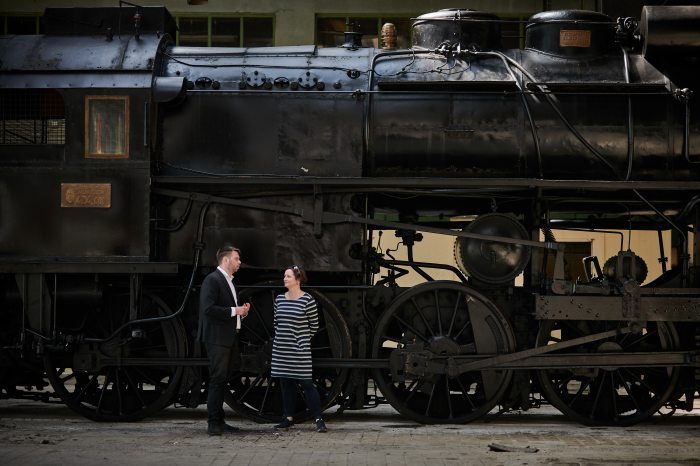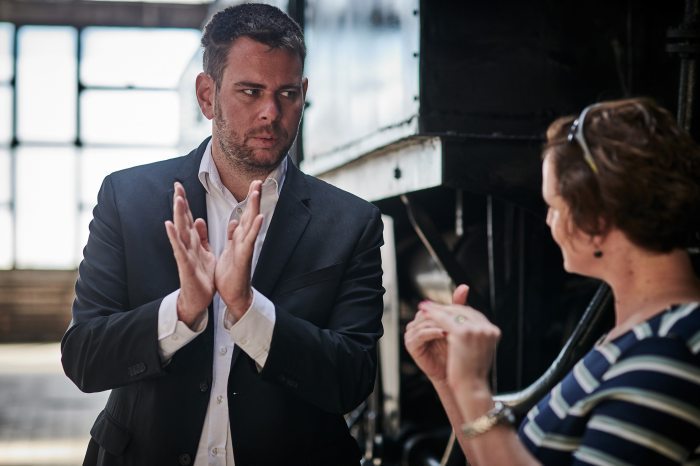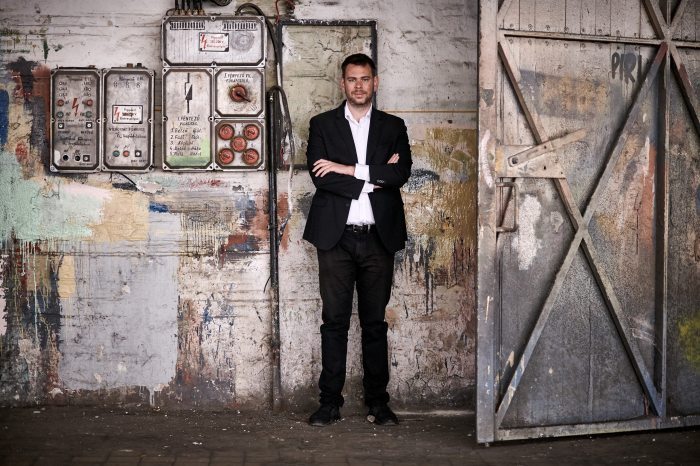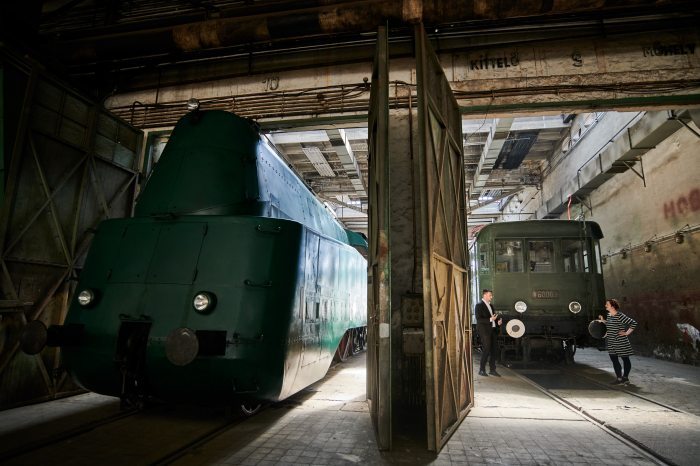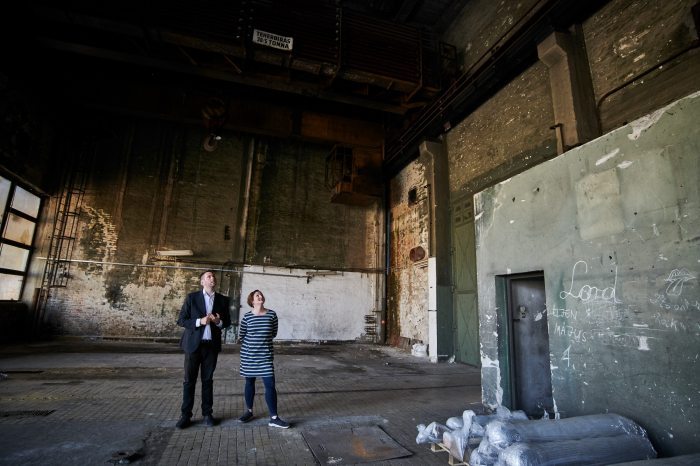On the model table of past and future – a conversation with Dávid Vitézy about the new Museum of Transport
We are in a fascinating place: the size and complexity of the disused Northern Vehicle Repair Diesel-Hall in Kőbánya will surprise and impress even the layman, let alone a professional who is familiar with and enthusiastic about all aspects of transport development. We meet Dávid Vitézy, CEO of the Budapest Development Center, and Director General of the Museum of Transport, here at the site of the future new Museum of Transport. I'm captivated by the novelty of it all, but he's not at a loss for words or ideas, even though he's obviously been to the huge industrial hall and its abandoned buildings a thousand times. He envisions an innovative, twenty-first-century museum, rich in experience and with lots of tangible, hands-on objects and as few screens as possible.
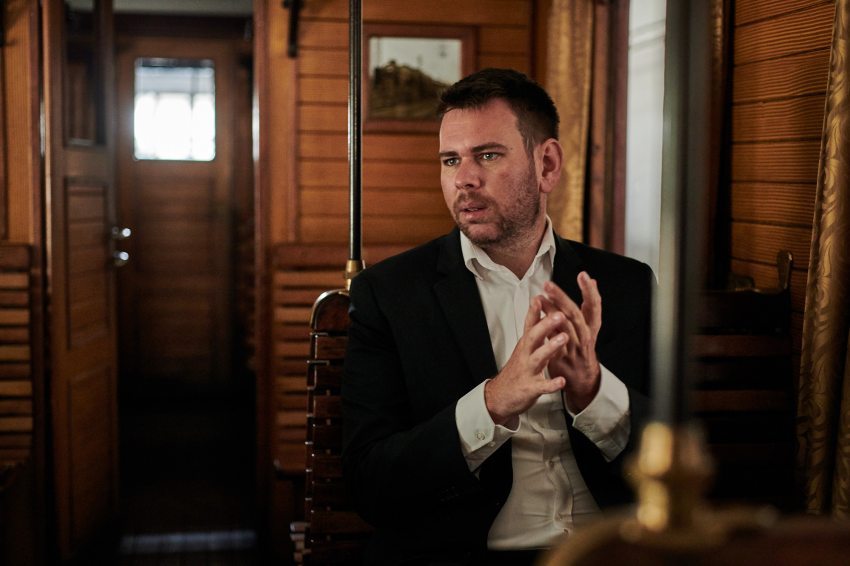
This more than 22,000 m² repair hall and the associated central office building of Hungarian State Railways’s (MÁV) vehicle repair plant were opened in 1962. It was built to the designs of the railway company's chief architect, György Kővári, and bears the hallmarks of the era. Part of it, not coincidentally, is also an industrial monument, and in architectural works, it is the distinctive external supporting structure and its replicas on certain internal decorative elements (such as the door handles) that are often referred to. If the hall had been built ten years later “in the glory of socialism”, it would probably not be worth looking at today - but in '62, the building, with its unique size and function, was designed and built using thorough and modern technical knowledge from before the war. As industrial buildings tend to be recycled from the pre-war era, the competition for the redesign was a unique and exciting challenge in the world architectural community, with some of the most prestigious firms bidding for the project, and an American entry winning.
The winning architectural firm, Diller Scofidio + Renfro, was the designer of the famous High Line, a disused elevated railway transformed into a park in New York. Together with their Hungarian partners, they are now working to save as much of the current building as possible - including the light fixtures and the hall numbers - while at the same time making the space, originally designed for the assembly of diesel locomotives, suitable for spectacular collection displays, visitor reception, and research. A skywalk is also planned: the vehicles will be viewable from above via bridges at crane level.
The adjacent steam hall, built long before, is now the Eiffel Workshop of the Opera House, and its spectacularly restored interior houses a steam locomotive, as good decor as it gets. The future Museum of Transport already has a large number of railway trains, of course, and the collection is constantly being expanded with new items of museum value. We start the conversation in front of the 424, which we know from a Tamás Cseh song, but the hall is also home to the Árpád railbus, the Kandó - named after its designer, several simple so-called ‘Bobós’ and ‘Ghosts’. The latter is one of the latest developments of steam-powered trains and holds the record for steam locomotives, speeding at 160 km/h when powered.
But it proved to be a dead-end - at that time, in the second half of the 20th century, it was no longer worth developing steam locomotives. There was the diesel one - and there could have been the electric one, too, as evidenced by the electric locomotive developed by Kandó Kálmán, also in the hall, but its importance has only increased in the last two decades. Humanity has realized what it had not for decades, that this technology is the most sustainable. Today, Dávid Vitézy says, there is only one line in the vicinity of Budapest that is served by diesel locomotives, and that too will soon be electrified. Kandó is one of those Hungarian scientific engineers whose work was not sufficiently appreciated in his own time, and we can only see in hindsight that he was actually ahead of his time.
We also walk through the other buildings belonging to the large halls: the repair hall with the mechanic's pit may retain its present form and will be the restorer's workshop, while the smaller halls will house a restaurant and café. But the fate of the Cold War nuclear bunker, which was built three stories deep and could have housed over a hundred people, is still to be decided. These are all very exciting places, with spectacular roof structures, cranes for loading, crane rails in the air, mines, and an engine room several stories high, a museum in itself. The restoration and conversion of the building is just one of the tasks - the concept for the exhibition must be developed, the content is being developed and restored, and the collection itself is being enriched.
Vitézy says of the schedule, "Three years ago the government decided to save this building as the new home of the Transport Museum. We launched an international architectural design competition, the winner of which, together with the Hungarian partners, is now working on the plans to obtain the building permit, followed by the design of the building, which will be ready by the end of 2022. At that time, the next government in office will decide - hopefully positively - that construction can start. If all goes well, the new museum could be open by 2026."
Talking about the concept of the content, Dávid Vitézy describes a vision that goes far beyond the presentation of vehicles and historical memories. "This exhibition is about the interaction between society and transport. It confronts us with what we have created in the world in the last fifty years under the name of transport, with what promises motorization revolution started, and with what faith we started to reduce the railways. The freight train was a wonderful option in the 19th century, it was fast, cheap, and could carry large quantities. In the twentieth century, it seemed a thing of the past, we had eliminated the siding, it felt slow and cumbersome, and trucking was taking everything away. Today we are at the point where the EU's environmental targets are that half of the freight transport will have to be shifted back from trucks to rail again to meet carbon reduction targets. A modern museum is suitable to present the challenges mankind is facing in a realistic way, with this perspective. At the same time, it will have a strong local context, presenting the Hungarian rail and automotive industry, the Hungarian technical and engineering tradition and heritage, the development history of Budapest and rural towns, and even the future of transport in Hungary.
If we can do this, Hungary's new Transport Museum will be a global benchmark. Valuable pieces of post-war architecture are often forgotten, and it will be, in fact, it is newsworthy in the world that Hungary has the sensitivity to save this iconic piece of architecture from that period. Hungarian technical and engineering knowledge is an important part of our national image, our self-image, and it is also part of our vision for the future, we believe that Hungarian innovation has a future on the global maps. This is one of the reasons for creating a world-class tourist destination here.
At the same time, we also want to strengthen the local thread by physically connecting the future museum to the Népliget (People’s Park), creating a walking route to it. Népliget also has a piece in its history connected to transport: on the one hand, car races were held here, and on the other, the first underground trains were tested on a test track here until the underground track was completed."
Obviously, lessons from history are particularly useful for someone who is also concerned with the development of transport in the present. Speaking about the synergies between the two tasks, I learn from the CEO that the construction of a station at the Népliget station is already being considered in the development of Budapest's largest rail development project to date, the Southern Circular Railway. A third track is also being built for the suburban railway, which is currently passing behind the vehicle repair hall, and a stop is planned for the future museum, not only to make the "Disneyland of the railway industry" conveniently accessible for people from the countryside but also to enable commuters from Hatvan and Pécel to transfer here to tram No. 1. They will have to go through the future museum garden to the tram stops.
The good news is that those who want to see the hall will not have to wait until 2026. This summer, a temporary exhibition of pieces from the collection that have something to do with the place will open.
"We are standing on a site," says Dávid Vitézy with no little enthusiasm, "that has been used for transport purposes since there has been any activity here. I want that when the museum is finished, everyone who visits it will leave with the feeling that there is no better and more authentic place for a transport museum in the world..."
Képmás magazine is launching a new series called Public Treasure, in which Kata Molnár-Bánffy, the publisher of Képmás, talks to dedicated people whose successful work can be of interest to many, and is a Public Treasure, as the title of the series suggests: a common issue, something we want to take care of.
